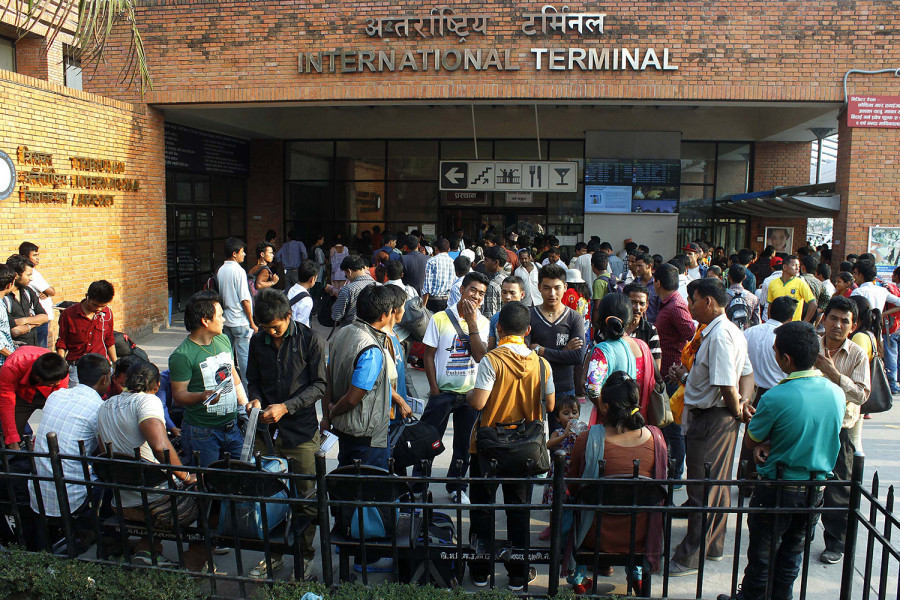Money
Remittance flow defies expectations to record a strong 8 percent growth
Nepalis abroad sent home Rs165.73 billion in the first two months despite a virus-ravaged world economy.
Sangam Prasain
Remittance inflows in the first two months of the fiscal year were down from the heady 23 percent growth in the first month, but the growth rate still hit a robust 8.1 percent.
According to Nepal Rastra Bank’s macroeconomic report released on Wednesday, Nepalis abroad sent back Rs165.73 billion in the two-month period even with the world economy in a tailspin due to the Covid-19 pandemic.
The central bank report said migrant workers sent home Rs73.02 billion during the period mid-August to mid-September. Nepal’s fiscal year begins in mid-July.
Economists said that the growth in money transfers, despite an early prediction by different global agencies that Covid-19 may crash remittance globally including Nepal, indicates that the manufacturing sector has returned to a normal situation.
“It was estimated that Nepalis working abroad would return home in the millions, with at least 2-3 million coming back, because of the coronavirus outbreak. But that did not happen,” economist Dadhi Adhikari told the Post. “That’s the key factor why remittance has not decreased despite several projections that Nepal would see remittance falling steeply.”
Adhikari said that in the initial days of Covid-19, the pandemic had spread fear among the millions of Nepalis living abroad, and they all wanted to return to the safety of their homes. “But Nepal’s poor health infrastructure forced them to remain where they were.”
He added that the Nepal government did not respond to the pleas of migrant workers, and international flights were restricted for several months.
Nepali migrant workers sent home Rs875.03 billion in the last fiscal year.
Nepal received an all-time monthly high of Rs100.16 billion in remittance in the last month of the fiscal year (mid-June to mid-July) that boosted overall earnings. With the coronavirus wreaking havoc on the global economy, remittance to Nepal was forecast to drop significantly.
In April-end, a little over a month after the lockdown was imposed on March 24, Nepal Rastra Bank had projected a drop of over 15 percent in remittances in the last fiscal year 2019-20. In the same month, the World Bank also projected remittances to go down by 14 percent. The Central Bureau of Statistics too projected a reduction of Rs163 billion, or over 18 percent.
“Now the remittance figure has given us an early indication that earnings will remain at the last fiscal year’s level despite the pandemic,” said Gunakar Bhatta, spokesperson for the central bank. “But still, with the beginning of the second wave of virus spread, things are looking uncertain globally, particularly in the service sector,” he said.
“But the manufacturing sector has, to some extent, returned to normal globally,” said Bhatta, chief of the central bank’s research department.
The International Monetary Fund is forecasting a somewhat less severe recession than it predicted in June.
According to its October 2020 World Economic Outlook Update released last week, global growth is projected at −4.4 percent in 2020, a less severe contraction than forecast in June.
The revision reflects better-than-anticipated second-quarter GDP outturns, mostly in the advanced economies, where activity began to improve sooner than expected after lockdowns were scaled back in May and June, as well as indicators of a stronger recovery in the third quarter.
Global growth is projected at 5.2 percent in 2021, a little lower than in the June Update, reflecting the more moderate downturn projected for 2020 and consistent with expectations of persistent social distancing.
According to the macroeconomic report of Nepal’s central bank, the number of Nepali workers (institutional and individual-new and legalised) taking approval for foreign employment plunged by 99.2 percent in the review period. Similarly, the number of Nepali workers (renew entry) taking approval for foreign employment decreased by 86.5 percent in the review period.
Bhatta said that the third month of the fiscal year (mid-September to mid-October) may also see a rise in remittance as Nepalis traditionally send home money for their families to celebrate Nepal’s biggest festival Dashain. “The fourth month's figure will give us a clear picture of how remittance is faring.”
Based on data from the Covid-19 Crisis Management Centre, more than 116,000 stranded Nepalis had been brought home as of October 20, most of them from labour destinations. The highest numbers were from the UAE with more than 33,000 migrant workers coming back home, followed by Qatar (21,000), Saudi Arabia (16,600), Malaysia (16,500) and Kuwait (9,800).




 15.24°C Kathmandu
15.24°C Kathmandu















